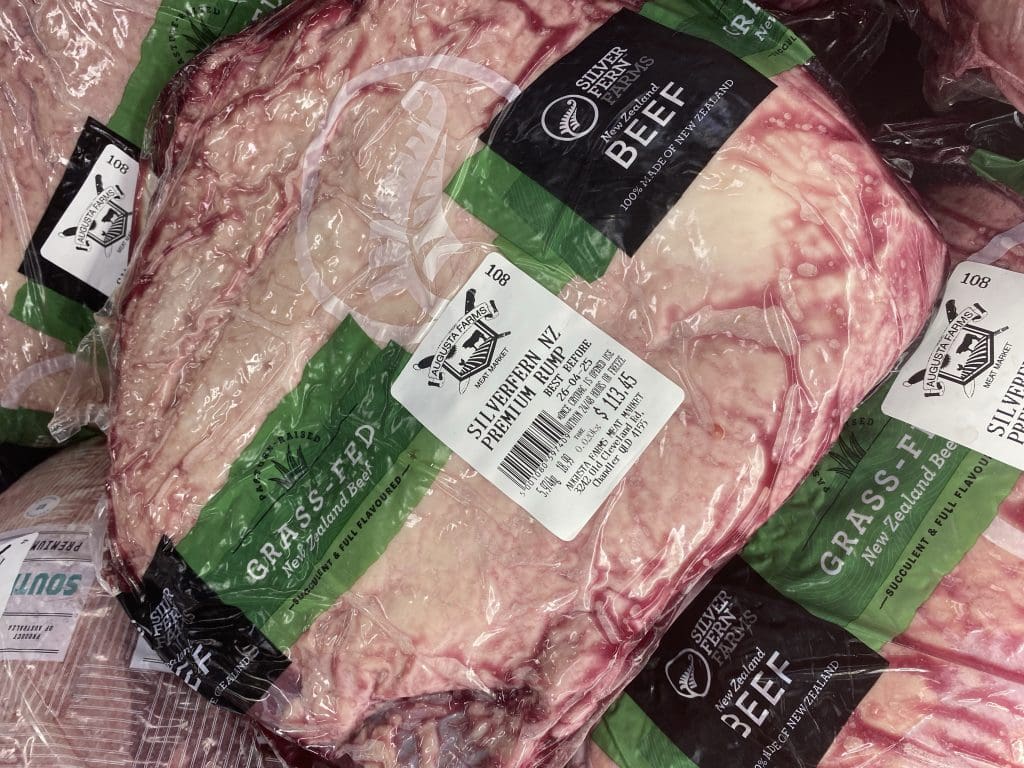WHILE there’s been as lot of focus during the past week on Trump tariffs and the possibility of United States beef re-entering the Australian market, it’s worth noting that small quantities of imported fresh beef are already being regularly sold in this country.
On Saturday last week, a large Brisbane retail outlet was offering these whole chilled grassfed rumps produced by New Zealand’s largest beef and sheepmeat processor, Silver Fern Farms. The product is being wholesaled here through large independent operator, Australian Wholesale Meats (AWM), with pack dates showing late February and early March.
While showing a little weep in the cryovac bags, the rumps presented well and were competitively priced at $19.99/kg. For comparison, there was a selection of other Australian whole rumps included in the same chilled cabinet, including Australian Meat Group’s Southern Grain program, also at $19.99/kg; a cheaper Ralph’s product, and Kilcoy grainfed rumps MS 1-2 at a bargain price of $17/kg.
New Zealand product is an infrequent, but occasional visitor to the Australian red meat market – mostly linked to the country’s peak beef production cycles in April, May and June. Production is currently ramping-up as the annual dairy cull takes place. In the back half of the year, NZ beef production declines sharply, and any limited product sold into Australia rapidly disappears.
New Zealand, along with Vanuatu (almost never seen) and Japan have active access to the Australian market. Japanese beef arrives in very small monthly airfreight shipments – all high-end Japanese Wagyu A4 and A5 destined for top Sydney, Brisbane and Melbourne hotels and restaurants. The largest importer is Japan’s Zenoh, formerly known as Zenchiku.
Before the US lost beef access to the Australian market back in 2003 following the discovery of BSE, very small quantities of US beef did find its way to these shores. The shipments were mostly whole grainfed rumps from US packers like Tyson, pushed into Australia during times of surplus.
They often appeared for only a week or two, before disappearing again.
DAFF import records show that the US beef shipments to Australia remained under 300t per year prior to 2003, despite the active trade extending deep into the 1980s. Competitiveness was the reason – prices in Australia did not justify large volume exports to this country at any point. Currency movement was occasionally a factor.
Volume of Australia’s beef imports from the US
| Year | Volume (tonnes) |
| 1995 | 263.4 |
| 1996 | 145.9 |
| 1997 | 151.3 |
| 1998 | – |
| 1999 | – |
| 2000 | 13.7 |
| 2001 | 13.6 |
| 2002 | 130.5 |
| 2003 | 12.5 |
| 2004 | 0 |
| 2005 | 23.5 |
| 2006-2023 | 0 |
Source: ABS 2025
NZ optimistic about prices
New Zealand’s cattle slaughter, heavily influenced by its large dairy industry, sees a seasonal pattern with peaks before winter followed by a decline until the summer months (November and December).
Beef + Lamb New Zealand’s Mid-Season Update issued this week says the country’s red meat sector is on track for a strong rebound, with farm profitability and export returns expected to rise significantly. Global demand, particularly from the United Kingdom, the European Union, the United States and Canada, has remained strong, helping to offset weaker demand from China.
As a result, export receipts are forecast to increase by NZ$1.2 billion on last year to reach $10.2 billion in 2024-25, despite lower overall export volumes.
B+L NZ chair Kate Acland said the improved global market conditions were encouraging, but challenges remained.
“This is a welcome turnaround for farmers following a tough 2023-24 season and a great result for New Zealand. Strong demand and a lower NZ dollar have lifted red meat prices,” she said.
“There are, however, risks on the horizon. We are keeping a very close eye on US trade policy developments which have the potential to create global market volatility.”
NZ farm-gate prices have lifted significantly this season. Cattle prices are projected to hit record levels, with an all-beef price of NZ618c/kg, 16pc higher than last season and 20pc above the five-year average.
Farm-gate prices for cattle are forecast to increase to record levels driven largely by the low beef cattle herd in North America.
In 2024-25, New Zealand’s export beef production is forecast to be 667,000t bone-in — a 1.5pc decrease from 2023-24. That reflects the drought driving lower production in the country’s South Island and fewer calves being reared two seasons ago in response to calf rearers’ expectations of future prices and margins.
Total production estimates for 2023-24 and 2024-25 have been revised up from December’s New Season Outlook publication.
“We expect to continue seeing farmers opting for more cattle instead of sheep, especially for finishing farms, as there are better gross margins and reduced labour costs,” B+L NZ said.
For 2024-25, the total number of cattle processed for export is forecast to be steady on 2023-24 at 2.6 million. Cow processing is forecast to be down 2.3pc as dairy farmers are expected to hold on to cows longer due to high milk prices, but this is offset by increases in the number of Steers and Bulls processed.


It was interesting to see some limited items of US beef back on display in Japan retail outlets this month. In February, I saw Mexican beef being retailed in Japan (striploin as sirloin steaks).
The US and Japan are in the lowest risk categories for BSE according to DAFF
https://www.agriculture.gov.au/sites/default/files/documents/bse-country-list.pdf
US beef and US cattle prices are currently the highest (or very nearly) on record. There is no commercial advantage in importing US beef to Australia excepting for some niche products.